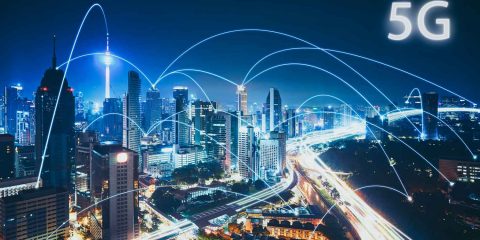- News & Resources: Listings >
- Blog
- How OCWA modernized water infrastructure with Cisco industrial IoT
- Redefining physical security in healthcare: A response to rising violence
- Emerging Cyber Threats in 2025: Tactics Redefining Digital Risk
- The Three Shields: How Firewalls Defend Modern Enterprises
- Workplace Safety in Crisis: Protecting Frontline Workers from Rising Threats
- The Role of Industrial Networking in Modern Manufacturing
- Why Cybersecurity for SMBs Must Be a Top Priority in 2025
- Together We Give: CMN and Umbrella’s Commitment to Support our Community
- The State of Shoplifting report reveals that 24% of shoppers switch stores due to shoplifting.
- How to Improve Safety and Security in Schools – Cloud Manage Network
- Top 10 Cybersecurity Threats in 2024
- Microsegmentation: Protecting Data from Cyber Threats
- Retail shoplifting and loss prevention: How to protect your business
- Generative AI Cost Optimization Strategies
- Why Do I Need to Protect My Cloud?
- 10 Reasons for Engaging Outside Experts to Manage Your Cybersecurity
- Why Hiring a 3rd Party MSP Expert Makes Sense and – and Cents (MANY cents!)
- Brand and Network Considerations When Adopting AI Corporately
- Integrating XDR, SIEM, and SOAR
- 3-2-1 –Go? Not so quick, this time.
- 5 Things a CISO Shoud Know
- 10-Step Patch Management Checklist
- Penetration Testing vs. Breach Attack Simulation
- Current big cyber breaches and impact on businesses
- Smart Infrastructure Gets Lit Up!
- Securing Industrial IoT: The Missing Puzzle Piece
- 7 Common Cybersecurity Mistakes Made by SMBs
- The Future of Physical Security: Cloud-Based Systems
- Autonomous and Sensor Technology Use Surging
- 2024 Facilities Trends Will Require Facilities and IT Teams to Work in Tandem
- NGFW vs. WAF. What’s the Right Firewall for You?
- Chris Hadfield’s Words To Live By
- Industrial Revolution 4.0 + IIoT
- Digital Fluency Drives Innovation
- Your Cloud Needs Protecting, Too
- Your building alarm systems could become obsolete. In 2024!
- Zero Trust 2.0: Zero Trust Data Resilience (ZTDR)
- We just got, or got used to, Wi-Fi 6. What is Wi-Fi 7?
- What Does the Board Need to Know? Business Metrics that CISOs Should Share – 4th and Last in a Four-Part Series
- Why 2024 is the Year for AI Networking
- International Women’s Day is Tomorrow – Great Time to Think About…
- Data-Centric Security Step One: Classifying Your Data
- The Network – Unsung Hero of Super Bowl LVIII
- What Does the Board Need to Know? Business Metrics that CISOs Should Share – Third in a Four-Part Series
- Boosting IT Team Performance by Fostering Intuition, Curiosity and Creativity
- Breach Remediation Costs Can Wipeout Bottom Line and Business
- Hoodied Hackers Now Favour Hugo Boss
- What Do You Need to Tell the Board? Business Metrics that CISOs Should Share – Second in a Four-Part Series
- How to Get People to Re-Engage After the Holidays
- What Does the Board Need to Know? Business Metrics that CISOs Should Share – First in a Four-Part Series
- Android Devices MUST be Updated + IT Departments Being Cut as Privilege Escalation Escalates
- Today’s Common Cloud Migration and Management Concerns
- Protect Your Healthcare Network from Cyberattack – Lives are at Stake
- Happy Halloween: Black Cats Lead to Boo….Hoo.
- Insurance Underwriters are Protecting Their Flanks
- Insurance Companies Cracking Down as Cybercriminals Become Better Business Builders
- Scary Cyberattacks Stats
- Parents, Profs and IT Professionals Perceive Back-to-School Through Different Lens
- Zscaler’s new IDTR and other tools that leverage generative AI
- Vanquish Vaping, Vandalism and Villainy
- Fabric for Fast-Paced Environments
- Changes to Cyber Insurance Requirements – What you Need to Know
- Cybersecurity Readiness – Newly Released Report
- Passwords Leaked…Again
- 10-Step Patch Management Checklist
- Remote – Again – For Now… and Still Maintaining Engagement
- Protecting Pocketbooks, Passwords and Property from Pilfering
- Raspberry Robin: Highly Evasive Worm Spreads over External Disks
- Cisco Introduces Responsible AI – Enhancing Technology, Transparency and Customer Trust
- Managing Customer Trust in Uncertain Supply Chain Conditions
- Hope on the Horizon
- Toys of Tomorrow… What will spark your imagination? Fuel your imagination?
- Protecting Purses and Digital Wallets
- The Password that Felled the Kingdom + MFA vs 2FA
- The MOE’s RA 3.0 and Zscaler
- 7 Critical Reasons for MS Office 365 Backup
- Penetration Testing Important, but…
- Social Engineering and Poor Patching Responsible for Over 90% of Cybersecurity Problems
- Breach Incidence and Costs On the Rise Again + 5 Ways to Reduce Your Risk
- Cybersecurity Insurance Policies Require Security Audits and Pen Testing
- Wireless strategies for business continuity gain importance as enterprise expand IoT, cloud, and other technologies
- How Cybercrooks are Targeting YOU
- Enabling Digital Transformation with Cisco SD-WAN
- WFH Post Pandemic – What It Will Look Like. What You’ll Need.
- Leaders to looking to the IoT to improve efficiency and resiliency
- Cyber Security Vernacular – Well, some of it, for now
- Why You Need Disaster Recovery, NOT Just Back-Ups
- 10 Reasons Why Having an Expert Manage Your Cybersecurity Makes Sense and Saves Dollars
- Converting CapEx IT Investments into Manageable OpEx
- The Hybrid Workplace – Planning the Next Phase
- Cisco Cloud Calling: Empowering Customers to Thrive with Hybrid Work
- When You Can’t Access the Cloud
- How to Keep On Keeping On
- New Cisco Research Reveals Collaboration, Cloud and Security are IT’s Top Challenges
- Threats from Within on the Rise
- Cloud Covered? If Not, Take Cover!
- Zero Trust and Forrester Wave Report
- Password Based Cyber Attack: Like Leaving Keys Under Doormats
- So, What’s Up With Sensors?
- Sensors and Systems Create a Digital “Last Mile” and Help Skyrocketing Costs
- Scanners Provide Peace of Mind for Returning Students and Workers
- Sensors Improve Operations and Bottom Line… Easily and Cost-Affordably.
- Cisco Meraki Looks at 2021
- 2020 Holiday Shopping: Cybersecurity and Other Tips to Safeguard Wallets and Systems
- How to make the most of the technology you have
- Personnel, Planet and Business Progress: More Interdependent Than Ever Before
- Sure… you can get them all in the boat – but can you get them to work well together?
- Pushing the Zero Trust Envelope – Cisco is Named a Leader in the 2020 Forrester Zero Trust Wave
- Cloud Data Must be Protected, Too!
- Don’t Let Anyone Get the Dirt on You – Make It Instead!
- How IoT Devices Can Help You and Your business
- WebEx – A World of Possibility
- Creating Your Breach Response Plan Now Will Save You Thousands Down The Road
- Been hacked? Here’s what you must do next.
- The Need for Pen Testing is At an All-Time High
- 5 Ways an IT Reseller Improves Your Performance and Peace-of-Mind
- 5G and Wi-Fi 6: Faster, more flexible, and future ready. Are you?
- Network and Data Security for Returning and Remote Workers + Disaster Recovery Symposium
- Collaboration and Cisco WebEx: Protecting Your Data
- Thursday’s Virtual Conference Tackles Today’s Supply Chain Trials and Tribulations
- 10 Tips to Reduce Cloud Storage Risk
- COVID-19 Crisis Fuelling IT Spending
- Supply Chain/Logistics Experts Share Their Expertise
- Cisco Breach Defence Overview
- Announcing Our New Website and Blog

5G, the 5th generation mobile network, which promises higher speeds with ultra-low latency, has started rolling across the country, starting with major urban centres. It will likely take 4 – 5 years for it to rollout across the globe, so 4G will be with us for a while.
The result is that many IT professionals are asking what is the real difference between the two, and why should I worry about it now?
While 4G networks can operate at a maximum speed of 300mbps-1Gbps, 5G has the capacity to operate at a speed of up to 20gbps. That is a massive increase. Imagine you were looking at movies. If 4G operated optimally at the 1gbps speed, you would have the potential to download a 15GB Blu-Ray movie in 2 minutes. That means if 5G were to operate at its maximum speed you could have the same movie downloaded in 6 seconds!
According to Doyle Research, 5G’s 1Gbps and higher bandwidth will have a significant impact on network configurations. It will give enterprise WAN managers more options for connecting branch sites and other remote users and like result in more adoption of SD-WAN.
The advantages of this higher speed are truly evident when you consider M2M (massive machine type communications). Machines will be able to bounce signals back and forth at speeds previously unattainable, with less effort required for the communication. This will result in lower better consumption increased operational efficiencies.

Other 5G advantages include speed and accuracy of authentication when roaming, improved ability speed of deployment such as you might need when providing WAN connectivity to a retail location or pop-up kiosk or office – something we are seeing more and more of with new COVID-19 protocols in place.
As 5G standards are enhanced, it is expected that there will be increased options for low-power IoT connectivity, too. The short term, IoT devices will need specific cellular compatibility to connect to 5G networks.
integrated into your private network. As with current cellular, some of the best applications are related to mobile connectivity and for use in industries such as agriculture, manufacturing mining, oil and gas, parts of supply chain management and other types of transportation.
Hospitals and other healthcare providers and manufacturers are also adopting 5G as it becomes available in their areas. For example, 5G has already had a major impact on surgical advancements. URLLC has allowed for the development of remote surgical tools such as the Da Vinci Surgical System. This system provides minimally invasive surgery and can be operated with higher accuracy than traditional tools, greatly reducing the risks associated with surgery.Without the lower latency offered from 5G networks, mission critical systems like the Da Vinci Surgical System would not be able to operate.
Think of it this way; 4G got the job done, but 5G makes the job efficient and expands the realm of what is possible. 4G shrunk information in order to make it easily accessible from things like cell phones and tablets, making it possible for rapid data and video download. 5G is making it possible to add networks to virtually anything, all while increasing speed and functionality by widening the path through which information can pass with high degrees of accuracy.
As you consider any kind of a network upgrade, or moving to an SD-WAN environment, it is important that you allow for potential adoption of 5G. Choosing technologies now that will accommodate both 4G and 5G, and access points that will work with Wi-Fi 6, will save you money, time and aggravation down the road.

That being said, using 5G will often require that you have more radio access points and, in these early days, there can be poor or no connectivity indoors. This means that you will need to assess how PCs, routers and other devices will be affected. Usually, using indoor micro cells, repeaters and distributed antennas will usually take care of the indoor problem.
For an assessment of what makes sense for your organisation now, and as it evolves, please feel free to contact us.
Such discussions usually require looking at Wi-Fi 6, too.
A little about Wi-Fi 6
Wi-Fi 6 is garnering a lot of attention because most IT professionals consider it to be the biggest evolution of the basic Wi-Fi standard ever, largely because of two of the technologies used: OFDMA (orthogonal frequency division multiple access) and Nunaimo. In essence, OFDMA allows concurrent uplink and downlink communication with multiple clients, and allows varying bandwidth needs to be searched simultaneously. This is especially useful when you have low bandwidth.
Using a delivery truck analogy this time, today’s Wi-Fi is like having a small panel truck that can only deliver one package to one person, and then has to return back to the depot. Thanks to OFDMA, and how it divides the spectrum, Wi-Fi 6 like having a large transport truck that can deliver multiple types of packages to multiple people on a single trip.
Considering this, you can see why Wi-Fi 6 and 5G both need to be part of your ongoing network assessments and discussions. Upgrading to WIFI 6 and 5G is more than just a wireless network upgrade, it can be a step towards better connected, higher-efficiency business – provided the adoption and deployment fully consider all aspects of your business, network and user requirements.
Again, this is an area in which Cloud Managed Networks excels. Please feel free to contact us at
416.429.0796 or 1.877.238.9944 (Toll-Free); we’d be happy to lend a hand.

